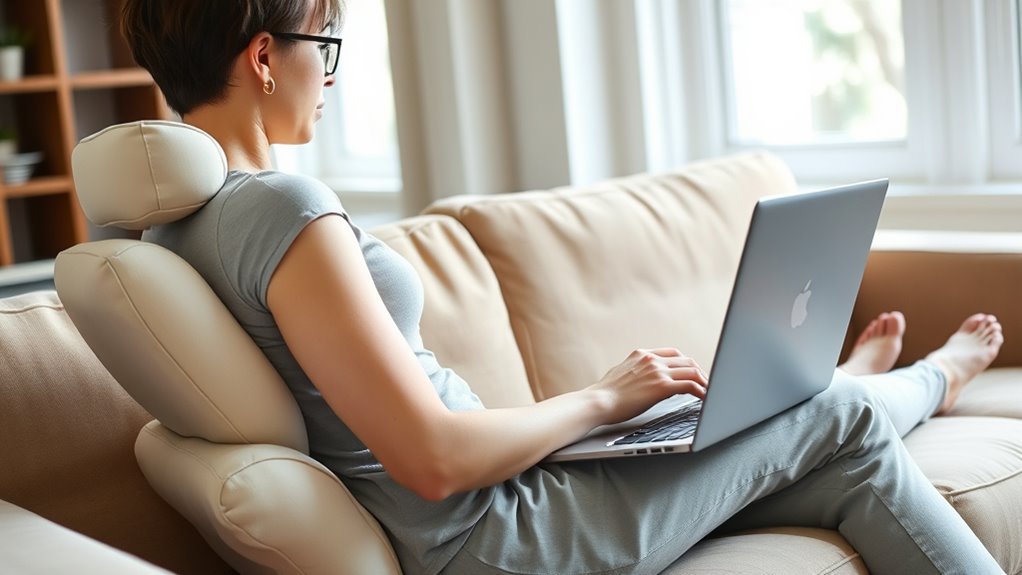To maintain good posture on the couch, sit upright with your back supported by cushions or lumbar supports. Elevate your laptop using a stand or lap desk with a built-in wrist rest, keeping the screen at eye level to prevent neck strain. Use an external keyboard and mouse to keep your hands neutral and shoulders relaxed. Take regular breaks and switch positions often to avoid stiffness. Keep exploring tips to improve your comfort and health even more.
Key Takeaways
- Use a lap desk with a wrist rest and elevate your laptop to eye level to reduce neck strain.
- Maintain proper seating by adding lumbar support and keeping hips aligned with or slightly above knees.
- Adjust your screen height so it’s at eye level, preventing neck craning and upper back tension.
- Take regular breaks every 20-30 minutes to stretch, change positions, and promote circulation.
- Keep shoulders relaxed, use external keyboard and mouse, and avoid leaning forward to promote ergonomic alignment.

Using a laptop on the couch can be comfortable, but it often leads to poor posture that causes discomfort or long-term injury. To avoid these issues, you need to pay attention to how you set yourself up. Ergonomic accessories can make a significant difference, helping you maintain proper alignment even in relaxed settings. For example, a lap desk with a built-in wrist rest can elevate your laptop to a more natural eye level, preventing you from hunching forward. Using a separate keyboard and mouse allows you to keep your hands and wrists in a neutral position, reducing strain. These accessories work together to promote better posture without sacrificing comfort.
Ergonomic accessories like lap desks and external keyboards improve posture and comfort on the couch.
Seating adjustments are just as important. Instead of slouching on the couch with your back unsupported, consider adding cushions or lumbar supports designed specifically for sitting. These can help maintain the natural curve of your spine and keep your shoulders relaxed. When placing cushions behind your lower back, you encourage a more upright position, which minimizes the tendency to lean forward and strain your neck and shoulders. Additionally, adjusting your seating height so that your hips are level with or slightly higher than your knees ensures your legs are at a comfortable angle, preventing tightness or numbness over time.
Keep in mind that your head position matters a lot. If you’re looking down at your screen, you’ll strain your neck and upper back. Use ergonomic accessories like a stand or riser that can lift your laptop to eye level. This way, you won’t need to crane your neck forward. When your screen is at the right height, your gaze remains straight ahead, and your neck stays aligned with your spine. Combine this with seating adjustments—such as sitting upright with your back supported—to further reduce tension in your upper body.
Another tip is to take regular breaks and change your position frequently. Even with ergonomic accessories and perfect seating adjustments, staying in one position for too long can cause discomfort. Shift your posture every 20 to 30 minutes, stretch, or stand up briefly. This habit helps keep your muscles engaged and prevents stiffness. Remember, the goal isn’t just comfort but also protecting your body from long-term damage. Incorporating ergonomic accessories into your setup can significantly improve your comfort and help maintain good posture throughout your couch time. By making simple adjustments and investing in ergonomic accessories, you can enjoy your couch time without sacrificing your health. Maintaining good posture is key to staying comfortable and avoiding pain, no matter where you choose to work or relax.
Frequently Asked Questions
What Are the Best Ergonomic Accessories for Couch Laptop Use?
To improve your comfort while using a laptop on the couch, consider ergonomic accessories like cushion support and adjustable stands. Cushion support helps elevate your hips and back, reducing strain, while adjustable stands allow you to set your laptop at eye level, preventing neck pain. Together, these accessories promote better posture, making your couch work sessions more comfortable and healthier. Always prioritize support and flexibility for ideal ergonomic benefits.
How Can I Reduce Eye Strain When Working on a Couch?
To beat bothersome eye strain, first focus on flickering screens and fatigued eyes. Wear blue light glasses to block harmful light, and adjust your screen brightness to match your environment. You might also take frequent breaks, follow the 20-20-20 rule, and blink often. These simple steps help soothe sore eyes, making your couch workspace more comfortable and keeping your vision vivid and healthy.
Are There Specific Stretches to Prevent Neck Pain?
To prevent neck pain, try incorporating neck stretches like gently tilting your head side to side and forward to stretch muscles. Shoulder exercises, such as shoulder rolls and arm circles, help relieve tension that can cause neck discomfort. Regularly doing these stretches and exercises keeps your muscles flexible and reduces strain. Remember to move slowly and hold each stretch for about 15-30 seconds, and avoid overstretching to prevent injury.
How Often Should I Take Breaks During Couch Laptop Use?
Like a gentle breeze, taking breaks refreshes your focus. You should aim for a break every 30 to 60 minutes during couch laptop use. Incorporate ergonomic routines by stretching and adjusting your posture during these breaks. This helps prevent strain and keeps you comfortable. Regular breaks boost productivity and reduce discomfort, so listen to your body and pause accordingly, making your workspace healthier and more sustainable.
Can Posture Tips Improve Sleep Quality After Working on the Couch?
Good posture tips can positively impact your sleep quality by promoting better sleep hygiene and more relaxing bedtime routines. When you sit with proper alignment during your evening activities, you reduce muscle tension and discomfort that might interfere with falling asleep. Incorporate stretches or gentle movements into your routine, and avoid screen time right before bed. These habits help your body wind down, making it easier to shift into restful sleep.
Conclusion
Remember, your posture is the foundation of your well-being, like a sturdy tree rooted deep in the earth. When you sit properly, you nurture your body’s strength and resilience, allowing you to grow and flourish even on the coziest couch. Keep your spine straight and your shoulders relaxed—your posture is the gentle compass guiding you toward health. Cherish this habit, and you’ll stand tall through life’s storms, grounded and unwavering.









